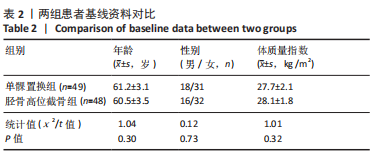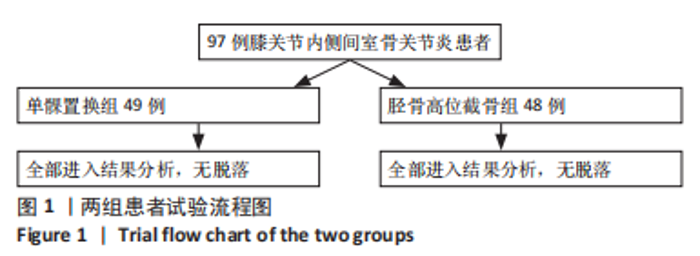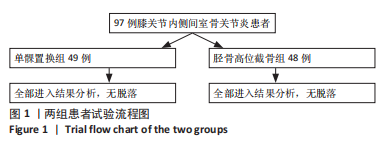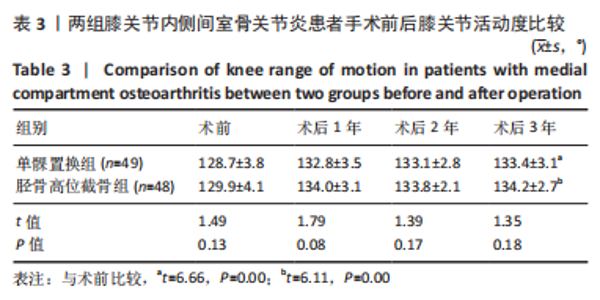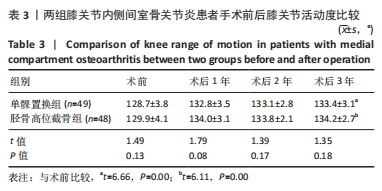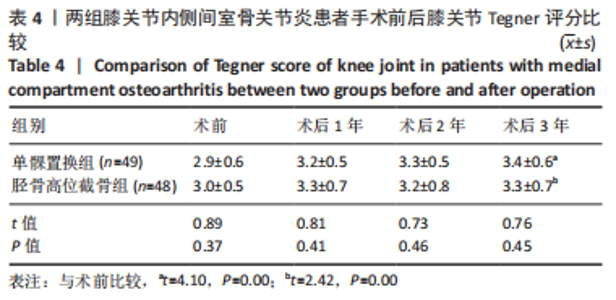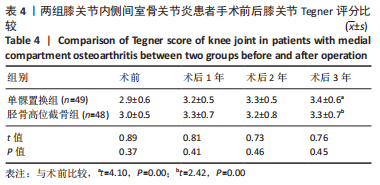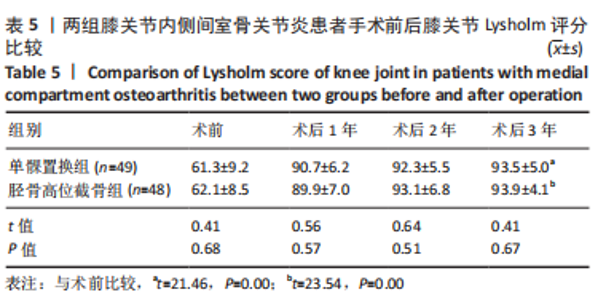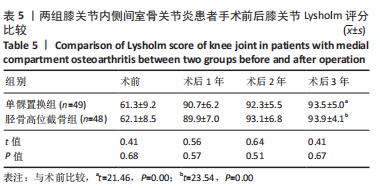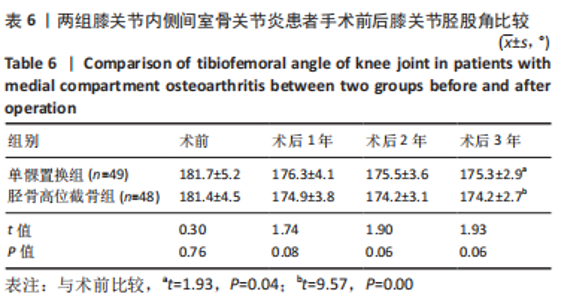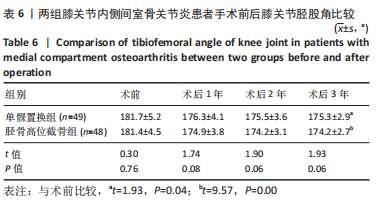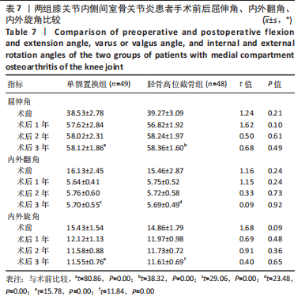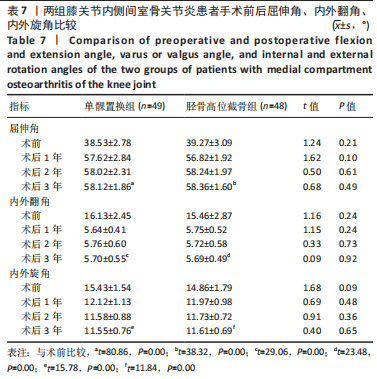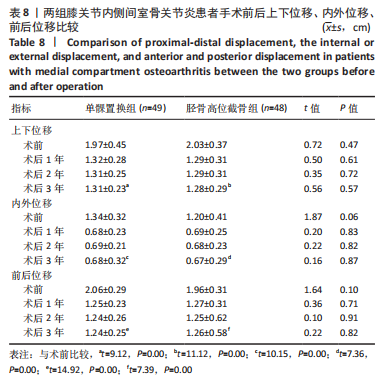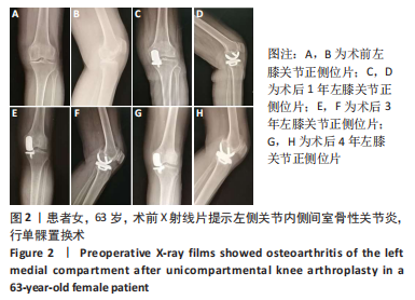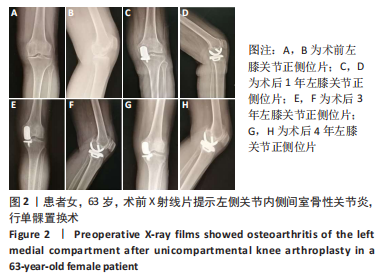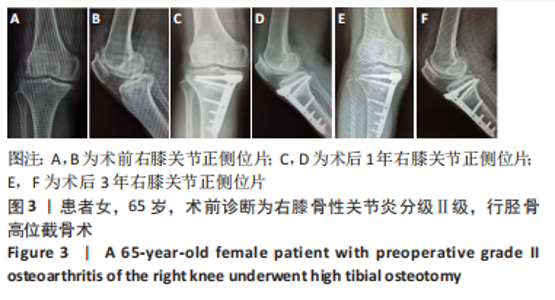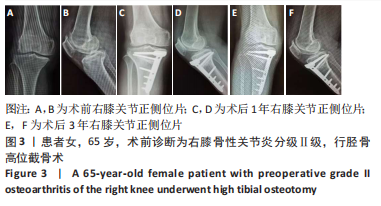Chinese Journal of Tissue Engineering Research ›› 2022, Vol. 26 ›› Issue (3): 390-396.doi: 10.12307/2022.064
Previous Articles Next Articles
Changes in kinematic parameters after unicompartmental knee arthroplasty and high tibial osteotomy
Liu Shaohua1, 2, Zhou Guanming2, Chen Xicong2, Xiao Keming2, Cai Jian2, Liu Xiaofang1, 2
- 1Foshan Hospital of Traditional Chinese Medicine Affiliated to Guangzhou University of Traditional Chinese Medicine, Foshan 528000, Guangdong Province, China; 2Tenth Department of Bone, Foshan Hospital of Traditional Chinese Medicine, Foshan 528000, Guangdong Province, China
-
Received:2020-10-19Revised:2020-10-22Accepted:2020-12-07Online:2022-01-28Published:2021-10-27 -
Contact:Liu Xiaofang, Chief physician, Professor, Doctoral supervisor, Foshan Hospital of Traditional Chinese Medicine Affiliated to Guangzhou University of Traditional Chinese Medicine, Foshan 528000, Guangdong Province, China; Tenth Department of Bone, Foshan Hospital of Traditional Chinese Medicine, Foshan 528000, Guangdong Province, China -
About author:Liu Shaohua, Attending physician, doctoral candidate, Foshan Hospital of Traditional Chinese Medicine Affiliated to Guangzhou University of Traditional Chinese Medicine, Foshan 528000, Guangdong Province, China; Tenth Department of Bone, Foshan Hospital of Traditional Chinese Medicine, Foshan 528000, Guangdong Province, China -
Supported by:the Research on Medical Science and Technology in Guangdong Province, No. 20161181228306 (to LSH)
CLC Number:
Cite this article
Liu Shaohua, Zhou Guanming, Chen Xicong, Xiao Keming, Cai Jian, Liu Xiaofang. Changes in kinematic parameters after unicompartmental knee arthroplasty and high tibial osteotomy[J]. Chinese Journal of Tissue Engineering Research, 2022, 26(3): 390-396.
share this article
Add to citation manager EndNote|Reference Manager|ProCite|BibTeX|RefWorks
| [1] PALAZZO C, NGUYEN C, LEFEVRE-COLAU MM, et al. Risk factors and burden of osteoarthritis. Ann Phys Rehabil Med. 2016;59(3):134-138. [2] LAWRENCE RC, FELSON DT, HELMICK CG, et al. Estimates of the prevalence of arthritis and other rheumatic conditions in the United States. Part II. Arthritis Rheum. 2008;58(1):26-35. [3] EGLOFF C, HÜGLE T, VALDERRABANO V. Biomechanics and pathomechanisms of osteoarthritis. Swiss Med Wkly. 2012;142: w13583. [4] VIGNON E, BRANDT KD, MERCIER C, et al. Alignment of the medial tibial plateau affects the rate of joint space narrowing in the osteoarthritic knee. Osteoarthritis Cartilage. 2010;18(11):1436-1440. [5] WALKER T, GOTTERBARM T, BRUCKNER T, et al. Total versus unicompartmental knee replacement for isolated lateral osteoarthritis: a matched-pairs study. Int Orthop. 2014;38(11):2259-2264. [6] RYU SM, PARK JW, NA HD, et al. High Tibial Osteotomy versus Unicompartmental Knee Arthroplasty for Medial Compartment Arthrosis with Kissing Lesions in Relatively Young Patients. Knee Surg Relat Res. 2018;30(1):17-22. [7] HAN SB, KYUNG HS, SEO IW, et al. Better clinical outcomes after unicompartmental knee arthroplasty when comparing with high tibial osteotomy. Medicine (Baltimore). 2017;96(50):e9268. [8] DETTONI F, BONASIA DE, CASTOLDI F, et al. High tibial osteotomy versus unicompartmental knee arthroplasty for medial compartment arthrosis of the knee: a review of the literature. Iowa Orthop J. 2010;30:131-140. [9] KIM YJ, KIM BH, YOO SH, et al. Mid-Term Results of Oxford Medial Unicompartmental Knee Arthroplasty in Young Asian Patients Less than 60 Years of Age: A Minimum 5-Year Follow-up. Knee Surg Relat Res. 2017;29(2):122-128. [10] 陈锐鸿,葛鸿庆,陈文治.单髁置换与胫骨高位截骨治疗膝关节内侧间室骨关节炎:1年随访比较[J].中国组织工程研究,2019, 23(20):3143-3147. [11] 郝朋,杨柳,何锐,等.人工单髁关节置换术后步态及临床疗效分析[J].中国修复重建外科杂志,2020,8(9):1-7. [12] WHATLING GM, BIGGS PR, ELSON DW, et al. High tibial osteotomy results in improved frontal plane knee moments, gait patterns and patient-reported outcomes. Knee Surg Sports Traumatol Arthrosc. 2020;28(9):2872-2882. [13] DUNN AS, PETTERSON SC, PLANCHER KD. Unicondylar knee arthroplasty: intramedullary technique. Clin Sports Med. 2014;33(1): 87-104. [14] LIM JW, COUSINS GR, CLIFT BA, et al. Oxford unicompartmental knee arthroplasty versus age and gender matched total knee arthroplasty - functional outcome and survivorship analysis. J Arthroplasty. 2014; 29(9):1779-1783. [15] 邓汝林,胡鸣舞,张虹俊,等.UKA与关节镜联合HTO治疗膝关节内侧间室骨性关节炎的疗效比较[J].南昌大学学报(医学版),2019, 59(3):74-78. [16] ZUIDERBAAN HA, VAN DER LIST JP, KLEEBLAD LJ, et al. Modern Indications, Results, and Global Trends in the Use of Unicompartmental Knee Arthroplasty and High Tibial Osteotomy in the Treatment of Isolated Medial Compartment Osteoarthritis. Am J Orthop (Belle Mead NJ). 2016;45(6):E355-E361. [17] 刘晓东,蔡珉巍,凃意辉.微创单髁置换术治疗膝关节内侧间室骨性关节炎的初步临床报告[J].中国矫形外科杂志,2010,18(7): 548-552. [18] LOBENHOFFER P. Indication for Unicompartmental Knee Replacement versus Osteotomy around the Knee. J Knee Surg. 2017;30(8):769-773. [19] BORUS T, THORNHILL T. Unicompartmental knee arthroplasty. J Am Acad Orthop Surg. 2008;16(1):9-18. [20] KOZINN SC, SCOTT R. Unicondylar knee arthroplasty. J Bone Joint Surg Am. 1989;71(1):145-150. [21] WONG T, WANG CJ, WANG JW, et al. Functional outcomes of uni-knee arthroplasty for medial compartment knee arthropathy in asian patients. Biomed J. 2014;37(6):406-410. [22] NWACHUKWU BU, MCCORMICK FM, SCHAIRER WW, et al. Unicompartmental knee arthroplasty versus high tibial osteotomy: United States practice patterns for the surgical treatment of unicompartmental arthritis. J Arthroplasty. 2014;29(8):1586-1589. [23] WILLIS-OWEN CA, BRUST K, ALSOP H, et al. Unicondylar knee arthroplasty in the UK National Health Service: an analysis of candidacy, outcome and cost efficacy. Knee. 2009;16(6):473-478. [24] ARGENSON JN, BLANC G, AUBANIAC JM, et al. Modern unicompartmental knee arthroplasty with cement: a concise follow-up, at a mean of twenty years, of a previous report. J Bone Joint Surg Am. 2013;95(10):905-909. [25] NIINIMÄKI T, ESKELINEN A, MÄKELÄ K, et al. Unicompartmental knee arthroplasty survivorship is lower than TKA survivorship: a 27-year Finnish registry study. Clin Orthop Relat Res. 2014;472(5):1496-1501. [26] JACKSON JP, WAUGH W. Tibial osteotomy for osteoarthritis of the knee. J Bone Joint Surg Br. 1961;43-B:746-751. [27] SONG SJ, BAE DK, KIM KI, et al. Long-term survival is similar between closed-wedge high tibial osteotomy and unicompartmental knee arthroplasty in patients with similar demographics. Knee Surg Sports Traumatol Arthrosc. 2019;27(4):1310-1319. [28] SCHUSTER P, GEßLEIN M, SCHLUMBERGER M, et al. Ten-Year Results of Medial Open-Wedge High Tibial Osteotomy and Chondral Resurfacing in Severe Medial Osteoarthritis and Varus Malalignment. Am J Sports Med. 2018;46(6):1362-1370. [29] 黄野.胫骨高位截骨术治疗膝关节骨关节炎的现状[J].中华关节外科杂志(电子版),2016,10(5):470-473. [30] PORNRATTANAMANEEWONG C, NUMKANISORN S, CHAREANCHOLVANICH K, et al. A retrospective analysis of medial opening wedge high tibial osteotomy for varus osteoarthritic knee. Indian J Orthop. 2012;46(4):455-461. [31] STUKENBORG-COLSMAN C, WIRTH CJ, LAZOVIC D, et al. High tibial osteotomy versus unicompartmental joint replacement in unicompartmental knee joint osteoarthritis: 7-10-year follow-up prospective randomised study. Knee. 2001;8(3):187-194. [32] 宋伟,朱振国,徐进,等.单髁置换术与胫骨高位截骨术治疗膝关节骨性关节炎的荟萃分析[J].中国矫形外科杂志,2018,26(21): 1962-1968. [33] MACFARLANE LA, YANG H, COLLINS JE, et al. Association of Changes in Effusion-Synovitis With Progression of Cartilage Damage Over Eighteen Months in Patients With Osteoarthritis and Meniscal Tear. Arthritis Rheumatol. 2019;71(1):73-81. [34] PRIMEAU CA, BIRMINGHAM TB, LEITCH KM, et al. Degenerative Meniscal Tears and High Tibial Osteotomy: Do Current Treatment Algorithms Need to Be Realigned? Clin Sports Med. 2019;38(3):471-482. [35] PRAKASH J, SONG EK, LIM HA, et al. High tibial osteotomy accelerates lateral compartment osteoarthritis in discoid meniscus patients. Knee Surg Sports Traumatol Arthrosc. 2018;26(6):1845-1850. [36] 罗旺林,殷德雄,彭超,等.胫骨高位截骨与单髁置换治疗单室膝骨性关节炎的荟萃分析[J].中国矫形外科杂志,2018,26(9):814-820. [37] 白浩,孙海飚,韩晓强,等.胫骨高位截骨与单髁置换治疗膝关节内侧间室骨关节炎的Meta分析[J].中国组织工程研究,2020,24(30): 4905-4913. [38] 杨波,姜鑫.单髁置换术与胫骨高位截骨术治疗膝关节内侧间室骨关节炎的近期疗效比较[J].中国修复重建外科杂志,2015,29(5): 548-552. [39] MOCHIZUKI T, SATO T, TANIFUJI O, et al. Unicompartmental knee arthroplasty cannot restore the functional flexion axis of a living knee to normal. Knee Surg Sports Traumatol Arthrosc. 2015;23(12):3736-3742. [40] 何利雷,赵立连,卢明峰,等.第四代Oxford单髁置换术对膝关节内侧间室骨关节炎患者的疗效评估及步态分析[J].生物骨科材料与临床研究,2020,17(4):21-25. [41] FU YC, SIMPSON KJ, KINSEY TL, et al. Does interlimb knee symmetry exist after unicompartmental knee arthroplasty? Clin Orthop Relat Res. 2013;471(1):142-149. [42] JUNG WH, TAKEUCHI R, CHUN CW, et al. Second-look arthroscopic assessment of cartilage regeneration after medial opening-wedge high tibial osteotomy. Arthroscopy. 2014;30(1):72-79. [43] KIM KT, LEE S, LEE JS, et al. Long-Term Clinical Results of Unicompartmental Knee Arthroplasty in Patients Younger than 60 Years of Age: Minimum 10-Year Follow-up. Knee Surg Relat Res. 2018; 30(1):28-33. [44] SPAHN G, HOFMANN GO, VON ENGELHARDT LV, et al. The impact of a high tibial valgus osteotomy and unicondylar medial arthroplasty on the treatment for knee osteoarthritis: a meta-analysis. Knee Surg Sports Traumatol Arthrosc. 2013;21(1):96-112. [45] FU D, LI G, CHEN K, et al. Comparison of high tibial osteotomy and unicompartmental knee arthroplasty in the treatment of unicompartmental osteoarthritis: a meta-analysis. J Arthroplasty. 2013;28(5):759-765. [46] SCHINDLER OS, SCOTT WN, SCUDERI GR. The practice of unicompartmental knee arthroplasty in the United Kingdom. J Orthop Surg (Hong Kong). 2010;18(3):312-319. |
| [1] | Wang Jianping, Zhang Xiaohui, Yu Jinwei, Wei Shaoliang, Zhang Xinmin, Xu Xingxin, Qu Haijun. Application of knee joint motion analysis in machanism based on three-dimensional image registration and coordinate transformation [J]. Chinese Journal of Tissue Engineering Research, 2022, 26(在线): 1-5. |
| [2] | Zhang Jichao, Dong Yuefu, Mou Zhifang, Zhang Zhen, Li Bingyan, Xu Xiangjun, Li Jiayi, Ren Meng, Dong Wanpeng. Finite element analysis of biomechanical changes in the osteoarthritis knee joint in different gait flexion angles [J]. Chinese Journal of Tissue Engineering Research, 2022, 26(9): 1357-1361. |
| [3] | Yao Xiaoling, Peng Jiancheng, Xu Yuerong, Yang Zhidong, Zhang Shuncong. Variable-angle zero-notch anterior interbody fusion system in the treatment of cervical spondylotic myelopathy: 30-month follow-up [J]. Chinese Journal of Tissue Engineering Research, 2022, 26(9): 1377-1382. |
| [4] | Jin Tao, Liu Lin, Zhu Xiaoyan, Shi Yucong, Niu Jianxiong, Zhang Tongtong, Wu Shujin, Yang Qingshan. Osteoarthritis and mitochondrial abnormalities [J]. Chinese Journal of Tissue Engineering Research, 2022, 26(9): 1452-1458. |
| [5] | Wang Baojuan, Zheng Shuguang, Zhang Qi, Li Tianyang. Miao medicine fumigation can delay extracellular matrix destruction in a rabbit model of knee osteoarthritis [J]. Chinese Journal of Tissue Engineering Research, 2022, 26(8): 1180-1186. |
| [6] | Wu Bingshuang, Wang Zhi, Tang Yi, Tang Xiaoyu, Li Qi. Anterior cruciate ligament reconstruction: from enthesis to tendon-to-bone healing [J]. Chinese Journal of Tissue Engineering Research, 2022, 26(8): 1293-1298. |
| [7] | Liu Dongcheng, Zhao Jijun, Zhou Zihong, Wu Zhaofeng, Yu Yinghao, Chen Yuhao, Feng Dehong. Comparison of different reference methods for force line correction in open wedge high tibial osteotomy [J]. Chinese Journal of Tissue Engineering Research, 2022, 26(6): 827-831. |
| [8] | Shao Yangyang, Zhang Junxia, Jiang Meijiao, Liu Zelong, Gao Kun, Yu Shuhan. Kinematics characteristics of lower limb joints of young men running wearing knee pads [J]. Chinese Journal of Tissue Engineering Research, 2022, 26(6): 832-837. |
| [9] | Zhou Jianguo, Liu Shiwei, Yuan Changhong, Bi Shengrong, Yang Guoping, Hu Weiquan, Liu Hui, Qian Rui. Total knee arthroplasty with posterior cruciate ligament retaining prosthesis in the treatment of knee osteoarthritis with knee valgus deformity [J]. Chinese Journal of Tissue Engineering Research, 2022, 26(6): 892-897. |
| [10] | Guo Xiaohui, Song Xizheng, Xiang Hanrui, Kang Zhaorong, Li Daming, Kang Yu, Hu Jun, Sheng Kai. External spinal fixation elastic stress in the treatment of jumping spinal fracture [J]. Chinese Journal of Tissue Engineering Research, 2022, 26(6): 919-923. |
| [11] | Xu Kuishuai, Zhang Liang, Chen Jinli, Ren Zhongkai, Zhao Xia, Li Tianyu, Yu Tengbo. Effect of force line changes on lower limb joints after medial open wedge high tibial osteotomy [J]. Chinese Journal of Tissue Engineering Research, 2022, 26(6): 821-826. |
| [12] | Xu Lei, Han Xiaoqiang, Zhang Jintao, Sun Haibiao. Hyaluronic acid around articular chondrocytes: production, transformation and function characteristics [J]. Chinese Journal of Tissue Engineering Research, 2022, 26(5): 768-773. |
| [13] | Wei Xing, Liu Shufang, Mao Ning. Roles and values of blood flow restriction training in the rehabilitation of knee joint diseases [J]. Chinese Journal of Tissue Engineering Research, 2022, 26(5): 774-779. |
| [14] | He Junjun, Huang Zeling, Hong Zhenqiang. Interventional effect of Yanghe Decoction on synovial inflammation in a rabbit model of early knee osteoarthritis [J]. Chinese Journal of Tissue Engineering Research, 2022, 26(5): 694-699. |
| [15] | Lin Xuchen, Zhu Hainian, Wang Zengshun, Qi Tengmin, Liu Limin, Suonan Angxiu. Effect of xanthohumol on inflammatory factors and articular cartilage in a mouse mode of osteoarthritis [J]. Chinese Journal of Tissue Engineering Research, 2022, 26(5): 676-681. |
| Viewed | ||||||
|
Full text |
|
|||||
|
Abstract |
|
|||||

